|
FAQs about Non-Vertebrate Animal Identification
64
Related Articles: Marine Invertebrates, Marine Invertebrate Systems, Marine Invertebrate Compatibility,
Marine Invertebrate Disease,
Marine Invertebrate
Reproduction, Quarantine of Corals and
Invertebrates, Feeding
Reef Invertebrates, Lighting
Marine Invertebrates,
Water
Flow, How Much is Enough,
Related FAQs: Non-Vert IDs 1, Non-Vert IDs 2, Non-Vert IDs 3, Non-Vert IDs 4, Non-Vert IDs 5, Non-Vert IDs 6, Non-Vert IDs 7, Non-Vert IDs 8, Non-Vert IDs 9, Non-Vert IDs 10, Non-Vert IDs 11, Non-Vert IDs 12, Non-Vert IDs 13, Non-Vert IDs 14, Non-Vert IDs 15, Non-Vert IDs 16, Non-Vert IDs 17, Non-Vert IDs 18, Non-Vert. ID 19, Non-Vert. ID 20, Non-Vert. ID 21, Non-Vert. ID 22, Non-Vert. ID 23, Non-Vert. ID 25, Non-Vert ID 26, Non-Vert ID 27, Non-Vert ID 28, Non-Vert ID 29, Non-Vert ID 30, Non-Vert ID 31, Non-Vert ID 32, Non-Vert 33, Non-Vert ID 34 Non-Vert ID 35, Non-Vert ID 36, Non-Vert ID 37, Non-Vert ID 38, Non-Vert ID 39, Non-Vert ID 40, Non-Vert ID 41, Non-Vert ID 42, Non-Vert ID 43, Non-Vert ID 44, Non-Vert ID 45, Non-Vert ID 46, Non-Vert ID 47, Non-Vert ID 48, Non-Vert ID 49, Non-Vert ID 50, Non-Vert ID 51, Non-Vert ID 52, Non-Vert ID 53, Non-Vert ID 54, Non-Vert ID 55,
Non-Vert ID 56, Non-Vert ID
57, Non-Vert ID 58,
Non-Vert ID 59,
Non-Vert ID 60,
Non-Vert ID 61,
Non-Vert ID 62, Non-Vert ID 63,
Non-Vert ID 65, & Marine Invertebrates,
Marine Invert.s 2,
Marine Invert.s 3, & FAQs about:
Marine Invertebrate Behavior,
Marine Invertebrate
Compatibility, Marine
Invertebrate Selection, Marine
Invertebrate Systems, Feeding
Reef Invertebrates, Marine
Invertebrate Disease, Marine
Invertebrate Reproduction, &
& LR
Life Identification, LR Hitchhiker ID
1, Anemone Identification,
Aiptasia
Identification, Aiptasia ID 2,
Worm Identification, Tubeworm ID, Polychaete Identification, Snail Identification, Marine Crab
Identification, Marine Invert.s 1,
Marine Invert.s 2, Marine Plankton,
|
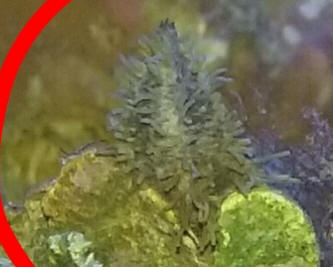 |
|
Strange Invader ID 8/19/17
Hello, I'm wondering if you can help me identify this strange thing in my tank?
I haven't added anything in a month or more, but just noticed it a week or so
ago. It was small - like a bit larger than the head of a pin,
but is growing quickly. It doesn't ever seem to be anywhere but on the glass. I
know the picture isn't great, but I don't have a good camera.
Any ideas? Thanks.
<Need a better (more resolved) pic... is this thing moving?
Some sort of worm or Nudibranch might be my guess if so. Not moving? Perhaps a
sponge of some sort. Bob Fenner>
|
 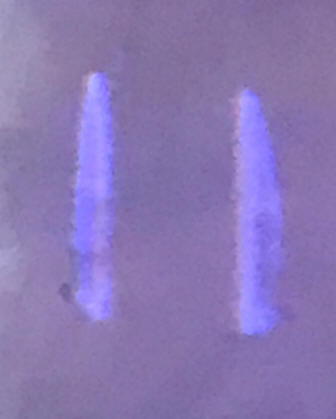
orig. w/ reflection and crop |
|
Salt Water Identification Assistance
7/9/17
Hoping you guys can help ID a new found presence in my aquarium.
Thanks! Chad H.
<The whitish bit? Have cropped, spiffed about as well as I can... appears to be
a bit of octocoral... likely a soft coral of some sort. You could excise. Bob
Fenner>
|
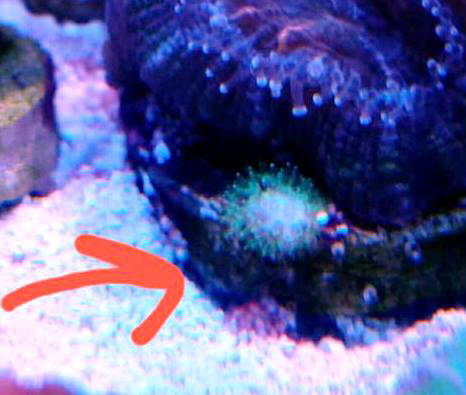 |
|
Nudibranch? 3/2/17
<14 megs? We only ask a few things; one is that folks limit their file sizes...>
I have a 65 gallon reed tank that is flourishing. I have very little problems
and all of my corals and inverts are doing very well. The only fish in the tank
is a mandarin goby. It is also doing well.
<..."often cited as Tritoniopsis or Tritonia. They commonly come in with leather
corals which is their pre.....">
In the last week, my newest addition (had been in tank about 2 weeks with no
problems) a 4 inch blushing leather coral, started to fail.
<Bingo; and BINGO was his name oh!>
One of its lobes died off. So, I moved it to a higher light zone. Slowly but
surely it died off one lobe at a time. It has completely disappeared as of about
3 days ago. Today, I saw what appears to be a large Nudibranch. I took a
picture. In your opinion, do you think this is the culprit? It actually looks a
little bit like a blushing leather in coloration. I wonder
if it was smaller before eating and went unnoticed until the leather was gone.
Now it is cruising the tank looking for more. Anyway, I can't find a similar
picture anywhere to identify this Nudibranch. Have you seen one like this
before? Do you know what it is?
<Please read here:
http://www.wetwebmedia.com/nudifaqs2.htm
Thanks,
Andy Brenham
<Welcome. Bob Fenner>
|
 |
|
Mystery hitchhikers on my frogspawn
2/10/17
Hello WWM crew!
<Kevin>
I was referred here from Bayou Reef keepers by Jordan Stari.
<Ahh! Hi to Jordan. Hope to catch up with him at this year's MACNA there>
He recommended that I post this query specifically directed toward Lynn Z
since she’s the invert expert. I have a mystery beastie on the base of two
of my branching frogspawn heads. When they first showed up, they were so
small I could barely tell they were something other than part of the coral.
Then I started noticing they had kind of a corkscrew antennae or
some other protrusion. I thought they might be some kind of
Nudibranch, but even with a magnifying glass, it was difficult to pick out
any distinguishing characteristics. I searched every site and message board
I could find to no avail. They are right at the boundary between the soft
tissue and the skeleton of each head and seem to retract into the soft
tissue if I shine a light on them for more than a few seconds. When I got
home from work today, one of them had come out far enough that it was ~1/2 –
3/4” long. I took some pictures, but only one of them is small enough in
file size to comply with WWM picture requirements and it is hard to see
anything on that one. I have attached it as a first look. If it’s okay, I
would like to post the best quality picture that shows it pretty well.
Please let me know if that is ok.
<Yes; though; I don't see what you're referring to. Lynn?>
I have had these corals for about two months and they have grown probably
2-3 times the size they were when I got
them in that time. Two of the heads have begun to split. Until about 4 days
ago, all seemed to be well. All of the corals in the tank have been given a
10 minute CoralRx Pro dip before being placed in the tank. I’m thinking that
since they emerged from within the soft tissue, maybe they were there from
the beginning and survived the dip.
In the pic, the dark vertical shape on the left is the branch of the
skeleton. The offending beastie is the whitish thing running parallel to the
branch (it is roughly ½-3/4” in length). As I said, I have better pics, but
did not want to run afoul of the posting rules.
<Do post elsewhere on the Net and send along links please>
Please let me know if you know what this is, whether I should worry about
it, and how I can get rid of it if necessary.
<Like grading school papers, "When in doubt, count it out", I'd vacuum,
remove this>
Thanks in advance for the help!
Kevin Drane
<Have sent on to LynnZ for her input. Bob Fenner>
|
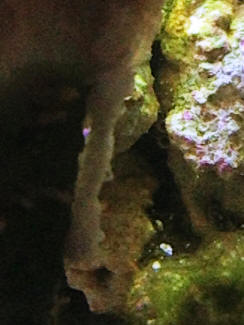
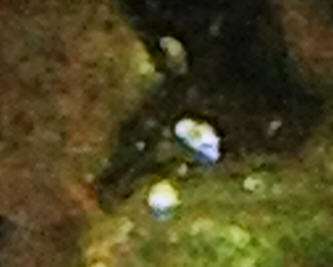 crop...
crop...
|
Re: Mystery hitchhikers on my frogspawn - 2/11/2017
Thanks for the quick response. I have a couple of pics posted on the Bayou
Reefkeeping forum. Here's a link:
Euphyllia eating Nudis?
<http://www.bayoureefkeeping.com/forums/topic/16109-euphyllia-eating-nudis/#comment-191958>
<Mmm; the little white bits right? I don't see rhinophores, gills on these...
Look more like Scutus... a snail on what little I make out... white shells
(could be overgrown), and black feet... No way for you to remove, shoot and send
a better close up pic?>
It seems to be hiding within the soft tissue of the coral because there are
times when you can't see it at all and then it just appears. Thanks again for
the help!
<The better pic please. Bob Fenner>
|
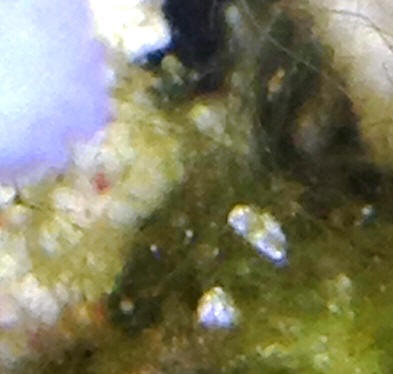 |
|
Re: Mystery hitchhikers on my frogspawn - 2/11/2017
Actually, the long white thing that is extending down from the base of the soft
tissue is one organism. The white bits are part of it.
<Don't see it mate>
There is no shell and it's all white. While it was extended out like that last
night, I tried to suck it out with a turkey baster and it held fast. I then
tried grab it with some tweezers and it still wouldn't come loose. It ended up
breaking in two. The part that was still attached retracted up into the coral's
soft tissue and I haven't seen it since. The part that broke off
kind of fell apart and the pieces were very small helical bits maybe 2-3 mm
long. My fire fish ate ended up eating the pieces. Now I'm worried that it is
going to die inside the soft tissue and as it rots will poison the coral. I'm
debating whether I want to break the heads free from the rock and dipping them
with Bayer.
<Have you considered fragging this colony? I might. B>
Re: Mystery hitchhikers on my frogspawn - 2/11/2017
Thanks for the quick response.
<<Hi Kevin and Bob. Sorry I’m a late arrival on this topic!>>
I have a couple of pics posted on the Bayou Reefkeeping forum. Here's a link:
Euphyllia eating Nudis?
http://www.bayoureefkeeping.com/forums/topic/16109-euphyllia-eating-nudis/#comment-191958
<Mmm; the little white bits right? I don't see rhinophores, gills on these...
Look more like Scutus... a snail on what little I make out...white shells (could
be overgrown), and black feet... No way for you to remove, shoot and send a
better close up pic?>
<<Unfortunately, I can’t see enough detail in the photos to determine exactly
what the subject is either. Offhand, it looks like a typical looping mass of
Cerith snail eggs - I’ve seen these before on Euphyllids. Please see the
following link for an example (bear in mind that these looping masses can be
variably arranged): http://www.nano-reef.com/topic/270550-whats-on-my-frogspawn/
. Do you have any of these snails in your system? If so, and this is an egg
mass, the multitude of loops should start breaking up and detaching within a few
days.>>
It seems to be hiding within the soft tissue of the coral because there are
times when you can't see it at all and then it just appears.
<<If this is an egg mass, perhaps it’s acting as an irritant? Honestly, I’m not
a coral expert so I’m not sure if it’s possible for the soft tissue on a
euphyllid’s stalk to react by trying to alternately envelop then repel an
irritant.>>
Thanks again for the help!
<The better pic please. Bob Fenner>
<<You’re very welcome. I just wish I could have given you a concrete answer.
Ditto what Bob said regarding a photo (if possible!). Take care, Lynn Zurik>>
<Thank you Lynn. B>
Re: Mystery hitchhikers on my frogspawn: Mesenterial Filaments -
2/11/2017
<Greetings, Kevin>
I do not have any Cerith snails
<There goes that theory! On the plus-side, I believe I have an answer for you.>
and I've never seen snail eggs move around like this.
<No, any movement would have to have been caused by something else: water
current, hatching individuals, instability/movement of whatever the mass was
deposited upon, or perhaps a critter of some sort wriggling about inside the
mass.>
Unfortunately, I can't get another picture because after I tried to pull
it off, it retracted back up into the soft tissue of the coral.
<Yep, this is normal (see below).>
There is no question in my mind that it is some kind of separate organism. I
have posted another picture to the forum- this time with annotation.
<Yes, I see – thanks. After thinking about this a bit more this morning, I
started wondering if what we were seeing was simply part of the coral itself,
and that was the ticket. All those loopy structures (that look like guts) did
indeed come from inside the coral. They’re mesenterial filaments
that, thanks to stinging cells/nematocysts, are used to capture/digest, as well
as fight off any threat/intrusion into a coral’s “space”. It could be that the
coral detected a threat (physical or chemical), and deployed the filaments. I
see a small collection of vermetid gastropods to the left of the filaments that
may be at least part of the issue. Vermetids send out sticky strands to catch
food particles that drift by. Those strands could be contacting the coral’s soft
tissue and irritating it. I ran across a photo at WWM that looks very similar:
http://www.wetwebmedia.com/carydisf7.htm . Please see the query at
the bottom of the page titled “Worm infestation… no -12/28/2007”, as well as a
WWM search for mesenterial filaments, Vermetids.>
I appreciate the time you have spent trying to help me.
<No problem, I hope this helps. By the way, if you decide to get rid of the
Vermetids, you can do so my either breaking them off with tweezers at the base
(do not use bare hands – the tubes are brittle and very sharp!), or seal the
tube openings with some gel-type Cyano glue.>
Hopefully the new picture will help you see it better.
<I think we’re good to go! Take care, Lynn Zurik>
Thank you Lynn. B <Always a pleasure, Bob!>
Follow-up Re: Mystery hitchhikers on my frogspawn: Mesenterial Filaments -
2/11/2017
Awesome! Thanks for the diagnosis.
<You are most welcome.>
Jordan was right that you know your stuff.
<Well, we all learned something this time! All I knew was that things weren’t
adding up, critter-wise, so I followed a hunch and it paid off.>
You just saved the coral from the trauma of being broken off the rock and dipped
again.
<Good>
I just knew it was some kind of parasite.
<I can certainly understand why.>
Unfortunately, in my haste to keep a parasite from harming my coral, I tore some
of its mesentery trying to remove it. Hopefully it recovers!
<I would think so.>
It all makes perfect sense now that I put all the pieces together. They had
(very small) Vermetids on them when I bought them as frags. The coral and the
Vermetids have both grown considerably since I got them.
<Yay, regarding the coral! As for the Vermetids, they thrive/multiply in high
nutrient conditions so do keep an eye on this. Same goes for what appears to be
some Spionid or Chaetopterid worms to the right of the mesenterial filaments. In
silhouette, you can see a number of paired feeding tentacles (“palps”). Although
not visible in the photo, these palps extend from hardened mucus tubes covered
with sand grains, bits of substrate, and/or shell. These worms are typically
harmless/beneficial particulate feeders/detritivores but when numerous can
irritate corals, particularly Zoanthids.>
In the last couple weeks, the coral has not been extending as much as it had
been. Now I realize it was due to the Vermetids growing as much as they have. I
will try scraping them off now that I know they are causing irritation.
<Good idea. Just be careful. You do not want to get a nasty infection after
cutting yourself on those sharp little shells!>
Thanks again!
<It was a pleasure! Take care, Lynn Zurik>
|
|
|
Id please? 10/31/16
Hi, can you please id this white substance? I thought maybe a type of sponge
but could not find it on your site. Thanks! Liana
<This is almost assuredly sponge/Poriferan material. To extents, assurance
of good system conditions here. Bob Fenner>
|
 |
|
Hiker on a Kenya Tree frag 8/25/16
Hello, I have something sticking out of my Kenya Tree base. I am afraid to
put it into my tank. People in forums think it is a brittle sea star.
I am not sure. Can you help?
<Yes to this being an Ophiuroid>
One picture is of a piece that fell off when we tried to remove it (thinking
it was a worm). The other is the undersigned of the rock base.
The others are various views of leg-like things.
Thanks!
<See WWM re. Bob Fenner>
|
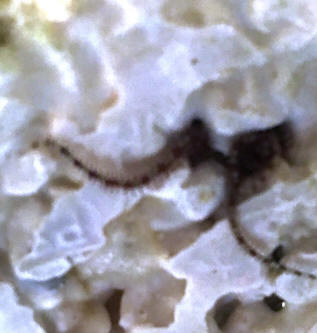
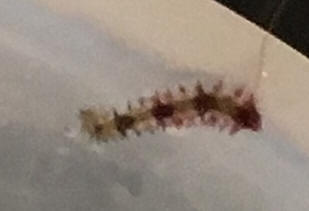 |
|
Re: Hiker on a Kenya Tree frag
8/25/16
Thank you. Are the beneficial? Should I be afraid to put in the tank?
<Keep reading! BobF>
|
|
What is this? 6/3/16
I purchased this from my LPS about 6 months ago. I though it was a sponge,
but it isn't. It seems to be growing rapidly and if I put it somewhere it
doesn't like to be it can expand to move itself from the crevice. Any idea
what it is....does it pose any threat to my saltwater tank (given off
toxins, etc.). Your expertise is appreciated.
Thanks!
<?! This is a soft coral... a Nephtheid.... See WWM re... your system must
be optimized and stable... for it to be doing this well. Bob Fenner>
|
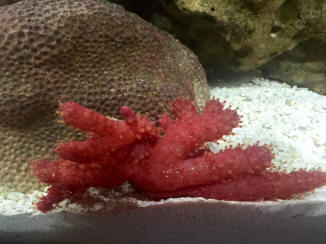 |
|
ID flatworm, Nudibranch or something else?
5/18/16
<Why six megs of uncropped pix files? See our limits please>
Hi, Just spotted it on the glass. Appears to be some type of slug / flat
worm. Real fast moving line down the middle of underside (I think) so
thinking fw but not sure, ears like a sea bunny Nude. Any ideas on id of
this little critter?
Thanks
<I see what looks like Rhinophores.... Bob Fenner>
|
 |
|
Re: ID flatworm, Nudibranch or something else?
5/18/16
Yes def Rhinophores so most likely Nudibranch. Any ideas which species so i
can work out what it eats before putting it back in the tank?
Thanks
<Doesn't look like any Sea Slug I've seen before; sorry. You might peruse
the many Nudi ID FAQs archived on WWM. B>
|
 |
|
Critter ID? 4/24/16
Any idea what this is? I thought it was a shed exoskeleton, but while
reviewing the pictures I took of it on the camera it disappeared quickly.
So I didn't see it move. It was about an inch long, I guess.
Thanks,
Lance
<Hi Lance...when you say "disappeared" do you mean it was blown away in the
current, or seemed to move away under its own power? If the former, my guess
is an exoskeleton or corpse.>
|
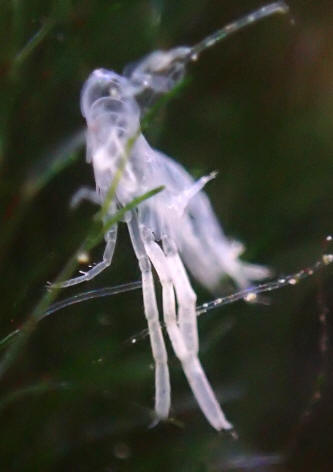 exoskeleton. B
exoskeleton. B |
floating eggs? 4/23/16
I came across a floating egg case in about 60ft
of water on surface( south side of Maui). The eggs were
black and resembled Cane Toad eggs but these were in arranged in a tube
about 3ft in length by 12in in height. Sorry I didn't think to
take pic but any ideas on identification? Thanks
<Salps? B>
Re: floating eggs?
Thank you Bob. It does appear to a Salp chain, it was my first encounter
and thanks again for the info.
<A practice guess. No fish egg rafts fit the description... the colonial
ascidians do. BobF>
|
Do you know what this is? It is my saltwater aquarium.
4/17/16
<Would like a better pic (esp. of the head area), but this appears to be an
Echiuran. Bob Fenner.
|

 |
|
Previously Unnoticed Zoanthid Neighbor 2/9/16
Greetings!
As a long time reader of the site (and now first time question asker) I would
like to say thanks up front for what you all do. There have been many times
where I was visited by the "Good Idea Fairy" and was saved by reading post after
post on here about why I should stop and rethink things.
<Ahh! Deeply gratifying to read, realize>
Anyways, while I was attempting to learn how to take decent pictures of my tank
I noticed an organism hiding in plain sight in the middle of a Zoanthid colony.
It appears to have two siphons (one on each side) and responds to
changes in light by quickly pulling them in.
<Good clues>
I have attached two photos- one with it in full extension and another after
being "bothered" by an object (with the Zoanthids retracted as well).
I have tried to compare it to as many pictures as I could reasonably on Google
images and the site here, but nothing seems to quite match.
Additionally, I posted the pictures in a reef club forum that I belong to and
got "oohs and ahs" but nobody there had apparently seen one either.
I'm not too concerned about it destroying or harming anything, just fascinated
by what it is and how I've missed it so far.
Thanks for any help you guys can provide!
Hank
<I suspect (my guess is on) either a tube worm of some sort/species, or a
vermetid snail; as these two groups are about all that fit your description and
photos. I would do nothing to remove this interesting animal; as it is not
harmful, nor likely to reproduce here (in this system). Thank you for sharing.
Bob Fenner>
|
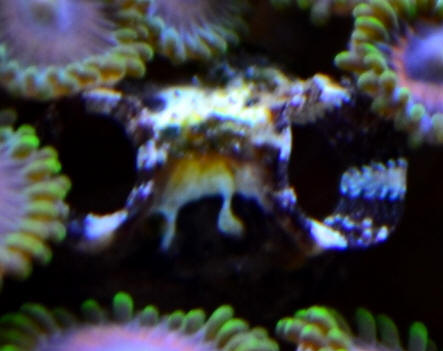
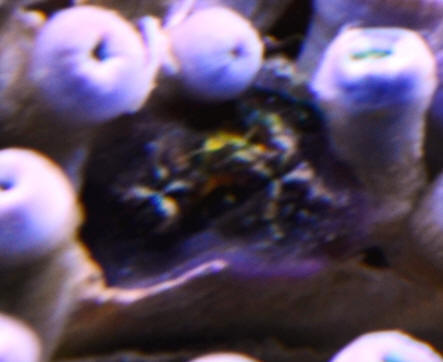 |
|
Cucs? Are they multiplying.
2/7/16
I'm new to the forum but have been reading your posts for years. A wealth of
info for the reader. Thank you. This (Florida Aquacultured) LR hitchhiker seems
to be multiplying. Arrived Thursday attached to a rock and didn't move. No
attempt to filter LS or (new dry) oolite, he just stayed attached to a rock
about a quarter of the way up in the tank. Yesterday I noticed
protruding ornamental-looking flowery tentacles coming in and out his rear end.
I thought he might be expunging his guts, but after looking online, guts (and
potential disaster poisoning) seems to be white sphetti-like strings (ruled out)
this is not what coming out of him. So I left him alone. This a.m. there are two
smaller versions of him where he was stationed and he's moved a few inches.
Mithrax crabs, stars, all other hitchhiking life seems unaffected by this event.
Upon inspection, I see two others of the same on the opposite side of the tank
perched high on LR. Those two seem to be attached by one end, one end sticking
up.
<Are these things actually moving?>
I want to know what they are and if they are multiplying. They are not sponges
but seem to be some species of Cucs.
<Maybe one or t'other... if mobile, my guess is on the latter>
I think it's reasonable the two perched high on the rock, on the other side of
the tank, crawled there overnight and are not related to the first one which
moved a apparently left two small duplicates of itself.
I'm attaching photos for some visuals. I hope they display. This is the first
forum post.
The first photo is the original hitchhiker. Note the flowery tentacles on the
(right) end. They move in and out.
<Strange... would you be willing to sacrifice one to dissect it?>
The second photo is the new small (hard to see in photo) duplicates.
The third photo are the two perched on end at opposite side of tank.
Unrelated most likely to the duplication event. For better ID of species.
This tank is newly cycling. Ammonia was 1.0 yesterday, Nitrites 0, Nitrates 0.
Today Ammonia 2.0, Nitrites 0, Nitrates 0, pH 7.9,
<Low pH from cycling>
temp 80 degrees.
Note: Because of the abundance of life on this live rock that is
cycling.
I did a 10% water change yesterday and I'm considering the 10% water change
today. I understand it's unorthodox, but I don't mind cycling slower to preserve
all the life on this rock.
<I would keep changing water; trying to keep ammonia under 1.0 ppm, and
pH above 8>
Thank you.
8kindsofcool
<Thank you for sharing. Bob Fenner>
|

|
|
Re: Cucs? Are they multiplying.
2/7/16
Bob,
<Car>
Thanks for the reply. Yes, the original animal moved to a new location two
inches upwards on LR from where it resided for two days upon placing the rock.
The duplicates move very slightly like caterpillars sometimes move,
moving only one end, probing the water but stay in their spot.
<I see>
They are soft and fleshy with (soft) short exterior tentacles and a dark colored
protrusion on one end.
<Strange. I'll admit, I've not seen this before>
The largest, 3" long x 1/2" thick "original" has a flowery ornamental curlyQ
hind-end that protrudes about a 1/2" at times. The exterior body tentacles
occasionally move, like a starfishes "feet" but not so much as to appear
actively searching for a food source.
One of the "duplicates" is about 1" long and "active" but remains stationary to
its place on the rock. There are two other "duplicates" less than 1/2" long that
look pod-like with definite dark protrusions on one end, their other end appears
"affixed" to the rock, in they have not moved from their position. I can see
than tiny life-like body movements, enough to appear alive. They are definitely
living creatures. None have shown interest in migrating to substrate. They
prefer to be on rock.
<Odd>
The two "newly emerged" specimens, which seemed to migrate into their current
upright position overnight are about 1 1/2" long, 1/3" thick, and are perched
like pineapples at the highest point in the tank. They are the farthest possible
distance from the "original" location wise. They were definitely not in that
location yesterday nor did I see them at all before this morning so I assume
these creatures are capable of climbing terrain and prefer it to sifting sand.
These two have rather pointy ends sticking upwards with no dark protrusions
showing. Their "base" end on the rock is thicker than their pointy tops.
I've found another, "vacationing" in a ledge.
The ones "sunning" (power compacts 76 watts total in 29 gal biocube) out in the
open and viewable, have snail-like short trunks. I don't know the scientific
term for this "snout". Photo provided.
They are all pink-gray in color and definitely the same species.
I will be happy to send one. Pls provide details. What cool thing will you send
to me? : )
<Heeee! Maybe my sister>
Note taken on water changes.
Carolyn
<I'd definitely keep them; but... what are they? Pennatulaceans? Some sort of
worm? New to me.
BobF>
|
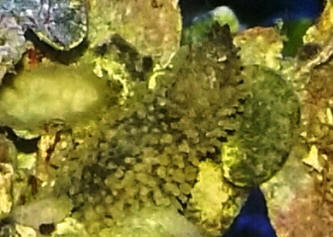
|
Re: Cucs? Are they multiplying. Cukes... likely in place from the get go
2/13/16
Bob, I don't want your sister, she won't fit in my 29 gal biocube.
<How 'bout if I throw in a car?>
The 1st attached photo is of the ornamental hind-end or mouth, whichever way you
want to look at it, of one of the "duplicates".
The 2nd photo is of another of these creatures cruising the glass.
To date, I have never seen one on the substrate. They prefer height.
Regards,
Carolyn
|
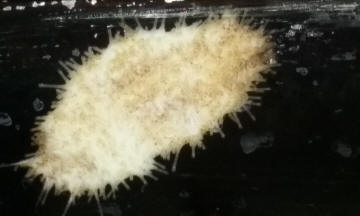
<Are these... the second pic...sea mice? Aphroditids? Do see the Net re... Bob
Fenner>
|
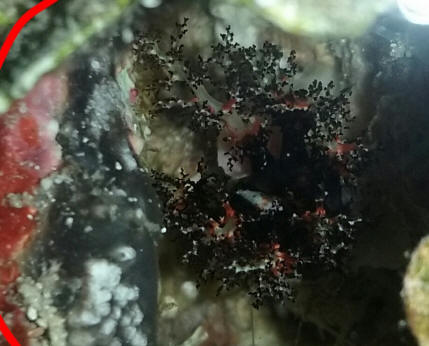
<The group pic appears to be Sea Cucumbers, Holothuroids. B>
|
|
|
|

